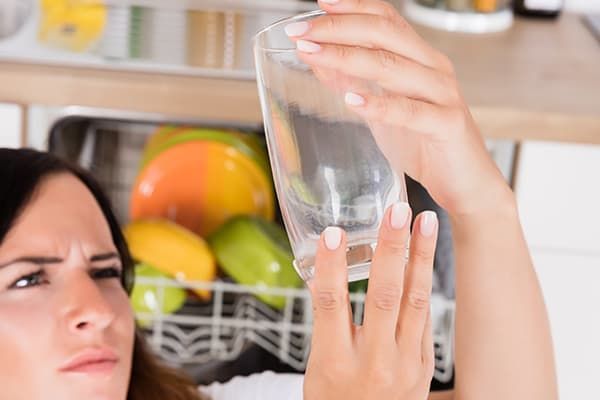Dishwasher Usage Tips for the Best Cleaning Performance
To Our Friends and Customers:
We would like to take this opportunity to provide our opinion on the way to get the best washability results from your dishwasher. This is information found in most use and care guides, plus additional content based on our experience as a professional appliance service company with 60 years of experience. Even though there may be slight differences based on the brand and model of the dishwashers, in general, this holds true for all.
About Dishwashers and Dishwashing Soap
First, a little bit of history; Phosphates were widely used by soap manufacturers to soften water and help soap attach to food and dirt particles to break down and rinse away. However, in 2011 the federal government passed a law prohibiting the use of phosphates in detergents which was found to be harmful to the environment and could cause health issues. Because of this, soap manufacturers had to change their product ingredients, some doing so more successfully than others.
Generally, we find that our water in Colorado tends to be on the hard side. It’s high in calcium, magnesium carbonates, sulfates, and chlorides. In the winter months, Colorado water is even harder when our waterways and reservoirs freeze allowing water to absorb more minerals. The harder the water, the greater the challenge in getting a good cleaning result in both the dishwashers and clothes washers.

How to Avoid Hard Water Spots
If you see a white film on the inside tub of your dishwasher, it is both hard water sediment and undissolved detergent. For homes without water softening systems, the absence of phosphates in soap to soften the water result in spotting (a very common complaint). Hard water-caused spotting is seen easiest on clear glassware. When the hard-water droplets are left on dishes dry, they leave behind hard-water mineral deposits which appear as unclean or spotted glassware. Car washes used softened water to provide a “spotless rinse” for the same reason. This is not the result of the dishwasher doing a poor job, but of hard water issues beyond the dishwasher’s control. Another common complaint is that the dishes don’t dry at all.
The solution to both of these issues is to use a rinse aid! Rinse aid is a chemical that causes water to “sheet off” stemware and dishware. The less water that remains on the dishes at the end of the cycle, the better the result from the dishwasher’s heating element evaporates the remaining water. With the water completely evaporated, there are no left-over minerals to leave spots on the dishes. Note: Plasticware is naturally more porous and retains water in the pores making it difficult for them to completely dry.
Getting Rid of Soap Buildup
Now let’s talk about undissolved soap buildup. Soaps are not effective in cooler temperatures. This is why the use and care guide instructs that at least 120° water temperatures are needed to provide a good washability result. Therefore, it is very important to run water to the sink faucet next to the dishwasher until the water runs hot. By doing so you’ve eliminated a pipe full of cold water between your water heater and dishwasher which will prevent your first water fill to be a tub full of cold water. Even though it is true that some dishwashers will heat the water using an element, the speed is very slow @ only 1 degree per minute. In addition, most will only heat water for a limited amount of time so the water may not ever get to an adequate temperature to properly activate and dissolve the soap. This additional effort can also increase the dishwashing cycle time to over 4 hours.
Dishwasher Cleaning Solution
It is very helpful to use a dishwasher cleaning solution once a month to get rid of the soap film and hard water deposits so they do not keep reappearing on your cleaned dishes. You can purchase a dishwasher cleaning product such as “Affresh Dishwasher Cleaner” or “Finish Dishwasher Cleaner” to use once a month or so at a cost of around $3 per dose.
Some soap products are bleached based which does a good job of removing stains such as coffee and lipstick. Other products are enzyme based which are good at breaking down oils and proteins from foods. Unfortunately, you can’t use both at the same time because the bleach will combat the enzymes causing them to be ineffective. Therefore, we recommend Finish Quantum pods or Cascade Platinum pods which contain both bleach and enzymes separated in the same pod and designed to dissolve at different times in the wash cycle thereby preventing them from fighting each other.
Scrape Off Excess Food
Before loading dirty dishes in the dishwasher, you must scrape off the excess food. No dishwashers have a built-in garbage disposal. However, you do not want to completely wash off all food debris because the soap needs something organic to interact with. With no organic matter to react to, soap will not dissolve completely and be left on dishes and on the inside of the tub (white film). Each dishwasher has between 2 and 5 filters that must be cleaned regularly. Not scraping off excess food will plug the filters more quickly and affect washability success. Preventing objects such as fruit pits, popcorn seeds, toothpicks, bread ties, etc is a must. These cannot dissolve and in some cases jam or bind the pumping impellers and spray arms. This will prevent the dishwasher from properly spraying the water around and/or prevent complete draining. All of this will lead to poor washability results.
Length Of Dishwasher Cycle
This brings us to the discussion of the length of time for a normal dishwasher cycle. Fifteen years ago, dishwashers used considerably more amounts of water. In addition, the heating elements were more powerful to heat the water and dry the dishes at the end of the cycle. Also, fans were used to assist in the drying process. Due to this, the cycles were shorter but still effective. Because of the federal guidelines mandating more energy-efficient appliances, manufacturers were forced to use less electricity and 1/3 the amount of water. To accomplish those goals the heating elements had to be less powerful, pump motors were less powerful, and fans were removed. To still achieve clean and dry dishes with the new dishwashers, the cycles had to be made longer to do more with less. That is why a normal cycle may take over 3 hours (but still use less electricity than before).
Think of it like this: You can jog a mile to get where you are going quicker, but you will expend a lot of energy doing so. You can walk a mile and still get to your destination using much less energy, it takes longer but you’ll still get there! During this 3+ hour normal cycle, the dishwasher fills, washes and rinses multiple times. Many dishwashers have a “one hour” or “quick wash” cycle. This cycle reduces the number of wash/rinse cycles, and the length of the cycles. These quick cycles will not be adequate for a typical set of dirty dishes.
When using the soap pod, it is still important to put the pod in the soap dispenser housing. This allows the dispensing of the enzymes and bleach in the second fill/wash cycle rather than the first, where the water will be at its hottest and therefore most effective.
We trust you find value in this information. If in the future you need repair for your appliances, we hope that you will give us a call. Our company is small enough to give you the attention you deserve, yet large enough to have the knowledge and experience to provide the professional experience you desire. Reliable Appliance Service! Trusted since 1964!

